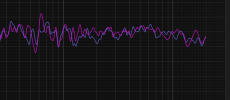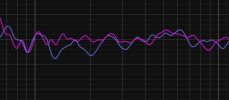I don't see any in-room environment noise problems in the operating range of the UniQ driver in AToMe's measurements. I have not seen anyone else but you who has said that the measurements were done incorrectly.
Maybe you missed it, but AToMe said he disconnected the bass drivers and only measured the UniQ drivers in the speakers. The UniQ drivers operate down to about 200Hz and then they pretty much nose-dive under that, so it's not strange at all if the noise floor happens to be up at 519% at 19.8 Hz which we see the numbers of, as the UniQ hardly makes any noise at all that low in the frequency range.
For the measurement for the other speaker, the noise floor at 19.8 Hz is down at 87%. This change in level is not very strange either as it can be from a passing truck, a neighbor who walked on the floor, or a change in the air conditioning. But no matter what it was, it's not necessarily important as it likely didn't affect the operating range of the UniQ that was measured.
Any "weird" reflection point will be the same for both speaker measurements as long as you are positioning the speakers at the same spot while measuring them, and nothing else is changed between the measurements.
Yes, that is the real.

That is how a well-matched pair of speakers will measure when measured at the same spot in the room, and it will not make a difference if they both are measured at 70 dB, 75 dB, or 85 dB and if they can both handle the same SPL.
Here are the measurements of my ATC SCM11s from almost the same spot in the room where the SCM40s were measured from. The smaller speakers are also a well-matched pair except for some larger deviations above 10kHz. I think most speaker manufacturers are referring to the range from 100Hz to 10kHz when it comes to matched speaker pairs.
View attachment 383692
Sorry, but it's not clear to me what you mean by your EDIT. Did you write something you decided to erase, if so I missed it.

The measurements of the two loudspeakers will of course look different if you don't measure them from the same spot in the room.
The measurements you see of my loudspeakers in this thread are just done to see how they match up pair-wise, that is the only purpose of these measurements. Therefore, the two speakers have taken turns being positioned at the same spot in the room to eliminate any environmental differences that would otherwise occur if they were positioned at different spots in the room.
You can easily try this yourself.
Measure one of your speakers, and mark that exact position on the floor so that you can measure your other speaker from that same spot without changing anything else. If you see large differences between the measurements (no matter where in the frequency response you see them) it means that the two speakers don't match very well, as the only parameter that is changed is the swapping between the two speakers taking turns being measured from the same spot in the room.
The only thing I expect to change in the new measurements is minor changes to the noise floor, and that will not affect the differences in the frequency response of the two UniQ drivers, not even the slightest as the level of the noise floor is way below the level of the fundamental signal.



